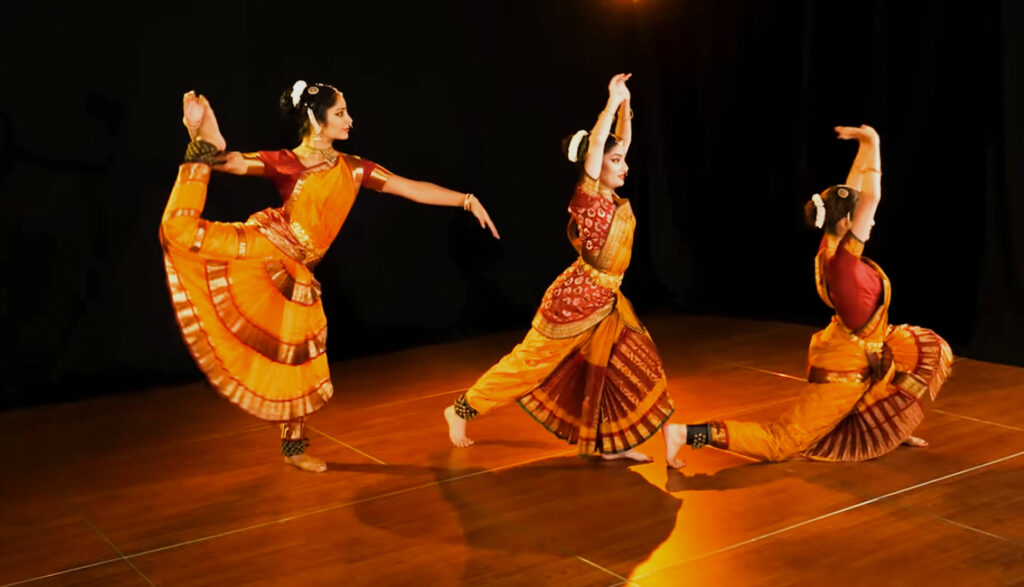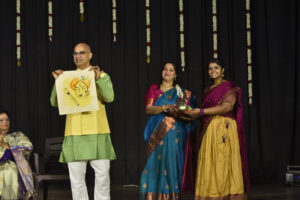Introduction: More Than a Debut, It’s a Legacy
An Arangetram isn’t just a performance. It’s a moment. A culmination of years of discipline, drenched in the sweat of practice, the rhythm of nattuvangam, the blessings of a Guru, and the dreams of a family. For families outside India, the challenge is twofold — staying true to tradition while navigating the logistics of an unfamiliar cultural landscape.
This book is your companion — not a how-to manual, but a practical guide & partner in this momentous journey. At Ragam & Thalam, we’ve stood beside parents and dancers, helping them shape a celebration that feels just as rich, rooted, and radiant as one back home.
Let’s step into this journey — with reverence for the Guru, applause for the artist, and love for the legacy.
Chapter 1: A Salute to the Guru and the Spark of Readiness
It begins, almost always, with a whisper. A passing comment from the Guru, a casual query from a parent: “Is she ready?” That’s when it starts. The slow, emotional, sometimes chaotic journey toward the Arangetram — a debut that is so much more than just a performance.
An Arangetram isn’t a recital. It’s a rite of passage. A dancer’s first solo stage performance, yes, but also a deeply symbolic milestone that marks the blossoming of an artist and the transformation of a child into a confident young adult. It’s a testament to years of sweat, sacrifices, discipline, and sheer love for the art.
But it’s not just the dancer’s journey. It’s the family’s too. Every costume change rehearsed in the living room, every playlist edit debated at the dinner table, every practice session where emotions run high — these moments bind the family together in a beautiful, if often exhausting, dance of their own.
The Guru — not just a teacher, but a mentor, a spiritual guide, a sculptor of souls. The Guru is the cornerstone. The one who plants the seed of devotion, waters it with knowledge and discipline, and then gently steps back to watch the artist bloom. Their role is immense. Sacred. Understated, but never forgotten.
Their word holds weight. It is the Guru who watches for that glimmer — the moment a student no longer just dances, but becomes one with the dance.
When that moment arrives, the Arangetram beckons. Not as a show of talent, but as a celebration of trust: the Guru’s in the student, and the student’s in the art.
Arangetram planning, therefore, cannot begin with logistics. So before the venue, the lights, or even the costumes — sit down with the Guru. Seek their blessings. Listen to their vision. Let their guidance shape the rest.
It must begin with intent. What does this milestone mean for your family? What kind of memory do you wish to create, not just for the audience, but for your dancer?
This chapter is your gentle nudge to begin not with checklists, but with clarity.
Chapter 2: The Family Orchestra – Juggling Roles Without Losing Minds
If the dancer is the soloist, the family is the orchestra. Each member plays a part, some in harmony, some (let’s be honest) in occasional dissonance.
Mothers become costume managers, publicists, hair stylists, and diplomatic liaisons to relatives who weren’t invited to the last function. Fathers transform into logistics coordinators, fundraisers, and the official “I’ll go get it” department. Siblings bounce between being proud cheerleaders and mildly annoyed stagehands.
Here’s the thing. You will argue. About budget. About flowers. About whether the opening prayer should be recorded or live. And that’s okay. Because behind the occasional tension is a shared pride. You’re building a legacy together.
The smartest families do this: they assign roles early. Treat this like a mini-project. There’s no room for “we’ll figure it out later.” Have a go-to person for vendor coordination, a task force for guest RSVPs, and a point person backstage. Document everything. Keep backups. And always — always — have snacks.
Remember, the goal isn’t to be perfect. It’s to be prepared and present. And to survive the final week without disowning each other.
Chapter 3: The Guru and the Dancer – A Sacred Bond
If Arangetram were a film, the Guru would be the silent yet powerful director. Behind every mudra perfected, every nritta polished, every eye glance nuanced — there is the Guru.
This is a relationship unlike any other. It’s not transactional. It’s transformational. A Guru doesn’t just teach steps. They pass on a living tradition. They mold the dancer’s character, confidence, and command over the stage.
The dancer, in turn, owes more than thanks. They owe reverence. And the Arangetram becomes not just a debut, but a tribute.
This chapter belongs to that sacred duo. When planning, ensure the Guru is involved in everything — from margam selection to stage layout. Keep them informed and respected. Make space for their preferences. Honour their contribution openly in the souvenir. And make time, amid all the hustle, for your child to simply sit with the Guru — in silence, in gratitude.
Years later, the dancer may forget the exact lighting used. But they will never forget how their Guru looked at them after the final Mangalam.
Chapter 4: The Dancer’s Journey — From Discipleship to Spotlight
Behind every graceful mudra is a child who stayed back after class. A teenager who skipped playdates for practice. A young adult who danced while friends partied.
An Arangetram is their story — of bruised knees, teary eyes, forgotten steps, and the triumph of overcoming all that. It is also a celebration of a child’s journey into adulthood — of the qualities that Bharatanatyam silently cultivated within: discipline, patience, confidence, and poise.
Many young dancers say later that it became their differentiator — a story in college applications, a highlight in a résumé, a spark in personality. The stage doesn’t just spotlight an artist; it molds a human being.
And so, it becomes a celebration for the entire family. A tribute to the behind-the-scenes machinery — the parents who ferried to class, the siblings who waited in the car, the grandparents who watched the first wobbly mudras.
Celebrate it all. Frame the childhood-to-now timeline. Show the dancer’s other talents — singing, poetry, science fairs. Let the audience see the whole person.
Chapter 5: The Countdown (A Human Timeline)
12–9 Months Before: – Sit with your Guru and ask the first question: Is the child ready? – Block a date that works for your community (avoid exams, major festivals). – Decide: Live orchestra (preferred) or recorded music? – Reach out to musicians — book early if bringing them from India. – Begin venue scouting based on guest count. – Chat with parents who’ve done it — they’re gold mines of wisdom.
8–6 Months Before: – Confirm with the Guru – the venue, orchestra, and chief guests. – Start discussing costumes, jewelry, and photo shoots. – Consult a physiotherapist or yoga trainer for stamina/knee strengthening.
5–3 Months Before: – Invitations — design begins now. – Finalize travel/stay plans for artists. – Book photography/videography. – Begin décor brainstorming and souvenir ideas.
2 Months Before: – Schedule tech rehearsals and stage walkthroughs. – Dry runs for makeup and costumes. – Guest list and RSVP tracking — start now.
Final Month: – Backstage planning, volunteer roles, emergency kits. – Coordinate food vendors and decoration teams. – Begin heartfelt countdown with your dancer.
Pro Tip: Juggling everyday life while planning an Arangetram is no joke. Between school runs, work calls, and family duties, sneak in planning in small, intentional windows. Use a shared calendar. Appoint a cousin as RSVP captain. And sometimes, just pause to laugh when it all feels too much — you’ll miss this madness later.
Chapter 6: Budgets and Emotions – Counting Coins, Measuring Joy
Let’s be honest. Planning an Arangetram is not unlike planning a wedding – minus the groom. The mix of heart and wallet decisions, the frayed nerves over napkin shades, the last-minute RSVP dropouts – it’s all there. And just like weddings, the Arangetram’s budget has a sneaky way of ballooning.
But before you reach for your calculator or your blood pressure pills, let’s break it down. Here’s a realistic, India-to-abroad inclusive guide to what it really costs to put up a memorable Arangetram.
The Realistic Budget Breakdown (Indicative Ranges)
| Expense Head | Indicative Range (USD) | Notes |
|---|---|---|
| Venue Rental | $500 – $3,000 | Depends on city, country, auditorium capacity, and hours booked |
| Guru Dakshina | $500 – $2,000 | Often not openly discussed; deserves utmost respect and generosity |
| Orchestra Fee (Live Team) | $1,500 – $3,000 | Includes airfare, honorarium, stay, food for 3–4 artists from India |
| Travel & Stay for Artists | $1,000 – $2,500 | May overlap with above; flights, hotel, transport, meals |
| Costumes (2–4 changes) | $300 – $1,000 | Purchase or rental; custom-fit silk with matching accessories |
| Jewelry (purchase/rent) | $200 – $800 | Temple jewelry sets, hairpieces, extra clips, safety sets |
| Makeup & Hair | $150 – $500 | Includes trial session and event day |
| Photography & Videography | $800 – $2,000 | Event coverage, editing, reels, teaser, and social media edits |
| Stage Décor & Lighting | $300 – $1,500 | Floral, thematic panels, LED backdrop, name board |
| Catering (Post-Event) | $800 – $3,000 | Sit-down or buffet; ~100–300 guests; Indian veg meals or fusion |
| Souvenir Printing & Design | $250 – $800 | Includes design, copywriting, printing, dancer profile, margam etc. |
| MC/Anchor | $100 – $300 | Optional but professional anchoring adds polish |
| Event Manager | $400 – $1,500 | Optional, but highly recommended for NRI or busy families |
| Miscellaneous | $200 – $800 | Gifts, welcome kits, stage tokens, emergency fixes |
Total Estimated Budget: $6,000 – $20,000
Yes, the range is wide – and for good reason. Families customize this day based on their vision, cultural expectations, available help, and of course, emotional bandwidth. It’s not just about how much you spend – it’s about how thoughtfully you spend it.
Emotions: The Unbudgeted Currency
Now for the part no spreadsheet can capture: the emotions. The lump in the throat when you see your child perform Alarippu like a seasoned professional. The Guru’s silent nod when they watch their student sparkle. The family huddle backstage during quick changes. The standing ovation from that one skeptical uncle.
You cannot budget for pride.
You cannot budget for legacy.
You cannot budget for the moment your child bows down to their Guru and touches their feet – and your own heart explodes into tears.
So yes, budgets matter. But emotions? They are the soul of this event. Count your dollars wisely, but don’t forget to count your blessings too.
Chapter 7: The Soul of the Event — Ritual, Rhythm & Reverence
A successful Arangetram is one where tradition breathes through every moment:
- Open with a Pushpanjali — a prayer, a grounding.
- Include the Varnam — the test of stamina and storytelling.
- Conclude with Mangalam — a thank you, a farewell.
Infuse cultural meaning into brochures — explain the compositions, acknowledge the Guru, and narrate the artist’s journey.
And if it’s feasible — choose live music. The synergy between dancer and musician is electric, magical, irreplaceable.
Chapter 8: Guests, Grace, and Gratitude
Your guests aren’t just attendees — they’re witnesses to a rite of passage. Make them feel part of something sacred:
- Personalize invites. Share a video teaser of the dancer’s prep.
- Offer brochures with meanings, translations, and anecdotes.
- Provide a livestream for loved ones afar.
- Keep refreshments simple but warm.
Don’t forget to thank them — genuinely, personally. Your child will remember the support.
Chapter 9: The Final Act — Rehearsals, Nerves & Magic
- Practice with the orchestra — non-negotiable.
- Create a Call Sheet for artists, vendors, volunteers.
- Ensure the stage is swept, mics are tested, and costumes are steamed.
The dancer may be nervous. You may be more so. Breathe.
This day will unfold not perfectly, but beautifully. The joy will outweigh the hiccups. Trust it.
Chapter 10: Watch-outs, Wisdom, and Wobbles
Every event has surprises. Some delightful. Some… not so much. Consider this chapter your secret stash of wisdom from those who’ve been there, done that — and lived to smile about it.
- Don’t overbook the dancer: Between rehearsals, costume trials, school, and life – burnout is real. Keep rest sacred.
- Rehearse the backstage flow: Costume changes, mic swaps, greenroom setup – do a mock run.
- Prep your helpers: Don’t assume everyone knows what’s expected. Write it down. Share it early. Assign.
- Print spares: Programs, invitation cards, schedule sheets. You’ll thank yourself.
- Lock your AV team: They’re the ones who will immortalize this day. Hire experienced people and share cue sheets in advance.
- Track RSVPs clearly: Use spreadsheets or apps to avoid catering misfires or seating chaos.
- Keep emergency kits: Safety pins, extra bindis, thread, glue, wet wipes, snacks, energy drinks. All of it.
- Take care of the dancer’s emotions: They might seem excited on the outside, but there’s pressure, vulnerability, exhaustion, and performance anxiety inside. Stay close. Stay kind.
Also, everyone will have an opinion — on décor, length, volume, or the sambar. Smile, thank them, and move on.
And finally, breathe. Something will go wrong. And that’s okay. Because what will go spectacularly right… is your child’s moment on stage. And that’s all that truly matters.
Remember, perfection is not the goal. Celebration is.
Chapter 11: The Final Bow – What Remains
The flowers wilt. The guests leave. The makeup is wiped away. But something lingers.
That final bow is not just an end. It’s a beginning. Of artistic identity. Of cultural confidence. Of memories that will echo every time the dancer hears the first beat of a mridangam.
Many dancers go on to teach, choreograph, or simply carry the discipline of classical dance into every walk of life. Many families realize just how much closer this journey brought them. And the Guru? They begin preparing the next seedling, as this one spreads its branches.
The Arangetram doesn’t end when the curtain falls. It lives on — in videos, photos, memories, and hearts.
So take that final bow. Then hug your child, your Guru, your team. And pat yourself on the back.
You made magic. Together.
Final Pranamams: A Standing Ovation
To the dancer — for their relentless spirit.
To the Guru — for their wisdom and grace.
To the parents — for believing, organizing, and cheering louder than anyone else.
To you, the reader — welcome to a journey that will stay with you forever.
About Ragam & Thalam
We’re more than planners. We’re memory makers.
We step in when the idea of an Arangetram feels overwhelming and walk with you until the final applause. With sensitivity to culture, reverence for tradition, and care for the artist — we bring your dream to the stage, just as you imagined.
Visit us at www.ragamnthalam.com
Take your first step: Download our checklist or book a free 15-minute consult. Let’s plan the performance of a lifetime.





